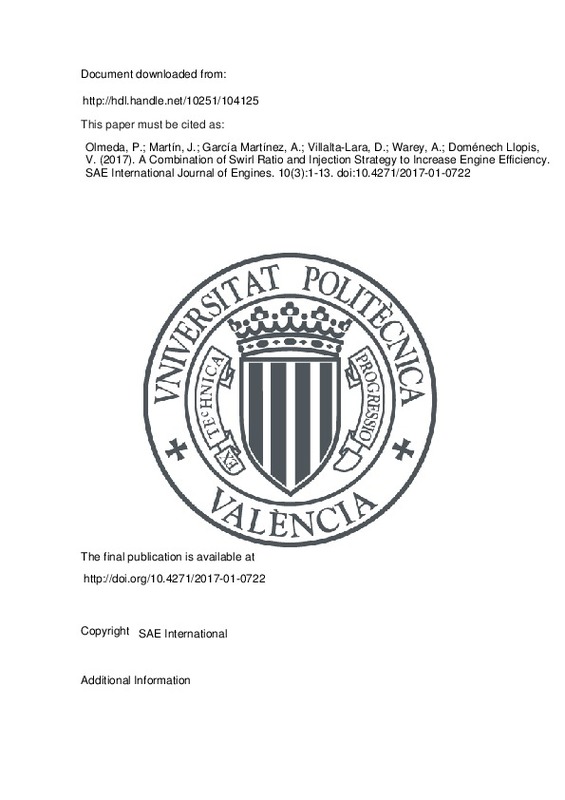JavaScript is disabled for your browser. Some features of this site may not work without it.
Buscar en RiuNet
Listar
Mi cuenta
Estadísticas
Ayuda RiuNet
Admin. UPV
A Combination of Swirl Ratio and Injection Strategy to Increase Engine Efficiency
Mostrar el registro sencillo del ítem
Ficheros en el ítem
| dc.contributor.author | Olmeda, P.
|
es_ES |
| dc.contributor.author | Martín, J.
|
es_ES |
| dc.contributor.author | García Martínez, Antonio
|
es_ES |
| dc.contributor.author | Villalta-Lara, David
|
es_ES |
| dc.contributor.author | Warey, Alok
|
es_ES |
| dc.contributor.author | Domenech Llopis, Vicente
|
es_ES |
| dc.date.accessioned | 2018-06-15T04:22:14Z | |
| dc.date.available | 2018-06-15T04:22:14Z | |
| dc.date.issued | 2017 | es_ES |
| dc.identifier.issn | 1946-3944 | es_ES |
| dc.identifier.uri | http://hdl.handle.net/10251/104125 | |
| dc.description.abstract | [EN] Growing awareness about CO2 emissions and their environmental implications are leading to an increase in the importance of thermal efficiency as criteria to design internal combustion engines (ICE). Heat transfer to the combustion chamber walls contributes to a decrease in the indicated efficiency. A strategy explored in this study to mitigate this efficiency loss is to promote low swirl conditions in the combustion chamber by using low swirl ratios. A decrease in swirl ratio leads to a reduction in heat transfer, but unfortunately, it can also lead to worsening of combustion development and a decrease in the gross indicated efficiency. Moreover, pumping work plays also an important role due to the effect of reduced intake restriction to generate the swirl motion. Current research evaluates the effect of a dedicated injection strategy to enhance combustion process when low swirl is used. For this purpose, a combination of theoretical (0D and 1D models) and experimental tools were used. In particular, experiments were conducted in a single-cylinder direct-injection light-duty diesel engine. The analysis also included theoretical calculations to estimate pumping losses. Results show that an increase in swirl ratio leads to an increase in the gross indicated efficiency (balancing heat transfer losses and combustion improvement) but the higher pumping losses negate this positive benefit. In the lowest swirl ratio case, a suitable injection strategy based on multiple injections, together with an increase in the injection pressure, can provide similar gross indicated efficiency as high swirl ratio case while avoiding high pumping losses. | es_ES |
| dc.description.sponsorship | The support of GM Global R&D and the Spanish Ministry of Economy and Competitiveness (TRA2014-58870-R,) is greatly acknowledged. | |
| dc.language | Inglés | es_ES |
| dc.publisher | SAE International | es_ES |
| dc.relation.ispartof | SAE International Journal of Engines | es_ES |
| dc.rights | Reserva de todos los derechos | es_ES |
| dc.subject.classification | MAQUINAS Y MOTORES TERMICOS | es_ES |
| dc.title | A Combination of Swirl Ratio and Injection Strategy to Increase Engine Efficiency | es_ES |
| dc.type | Artículo | es_ES |
| dc.identifier.doi | 10.4271/2017-01-0722 | es_ES |
| dc.relation.projectID | info:eu-repo/grantAgreement/MINECO//TRA2014-58870-R/ES/REDUCCION DE LAS EMISIONES DE CO2 EN VEHICULOS PARA TRANSPORTE USANDO COMBUSTION DUAL NATURAL GAS-DIESEL/ | es_ES |
| dc.rights.accessRights | Abierto | es_ES |
| dc.contributor.affiliation | Universitat Politècnica de València. Departamento de Máquinas y Motores Térmicos - Departament de Màquines i Motors Tèrmics | es_ES |
| dc.description.bibliographicCitation | Olmeda, P.; Martín, J.; García Martínez, A.; Villalta-Lara, D.; Warey, A.; Doménech Llopis, V. (2017). A Combination of Swirl Ratio and Injection Strategy to Increase Engine Efficiency. SAE International Journal of Engines. 10(3):1-13. doi:10.4271/2017-01-0722 | es_ES |
| dc.description.accrualMethod | S | es_ES |
| dc.relation.publisherversion | http://doi.org/10.4271/2017-01-0722 | es_ES |
| dc.description.upvformatpinicio | 1 | es_ES |
| dc.description.upvformatpfin | 13 | es_ES |
| dc.type.version | info:eu-repo/semantics/publishedVersion | es_ES |
| dc.description.volume | 10 | es_ES |
| dc.description.issue | 3 | es_ES |
| dc.relation.pasarela | S\334845 | es_ES |
| dc.contributor.funder | Ministerio de Economía, Industria y Competitividad | es_ES |







![[Cerrado]](/themes/UPV/images/candado.png)

